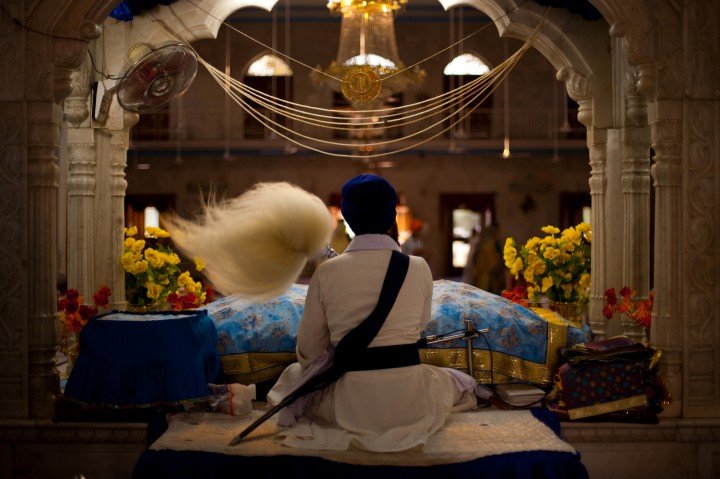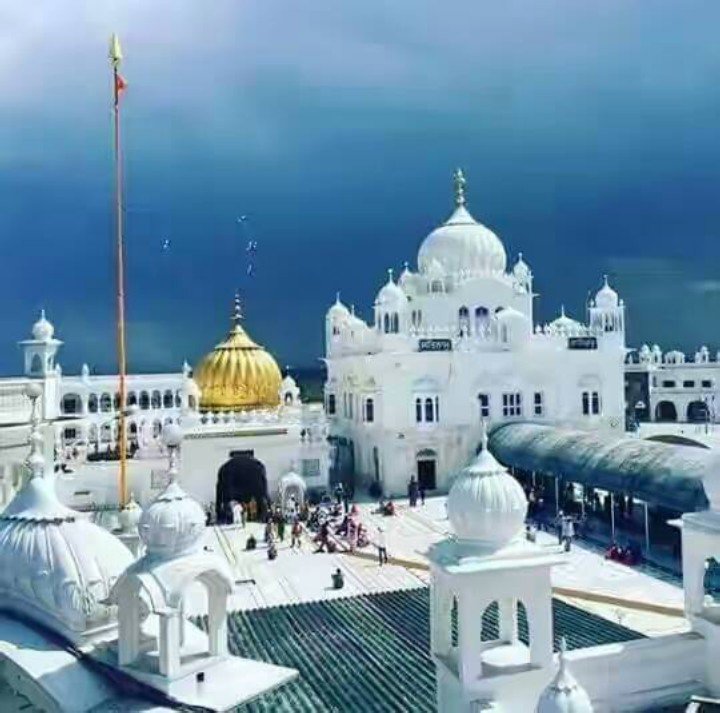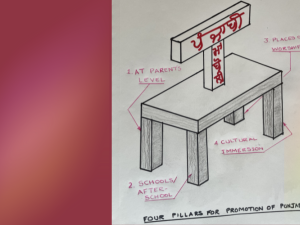It is time of the year when we celebrate the creation of Khalsa at Anandpur Sahib by Guru Gobind Singh Ji on 14th April 1699. On this day at the special invited celebration Guru Gobind Singh Ji gave a clarion call of "I want one head." to the assembled audience. We are not going to go into the details of what transpired there on that day, suffice to say Guru Ji was looking for one who did not have fear of death. He got five volunteers one after the other who offered their heads and he took them into a separate tent. Guru Ji initiated them into the order of Khalsa with Amrit. This Amrit used in the initiation ceremony was prepared with stirring of water from River Sutlej in a Batta (bowl of iron) with a Khanda. While stirring with the Khanda five banis - Japji Sahib, Jaap Sahib, Tav Parsad Saveeyae, Chaupai, and Anand Sahib were recited. These banis transformed the water into Amrit. The five who offerd their heads drank it and become known as Five Beloved. So today, on this occasion let us refresh the history and our understanding of these five Banis. Through this process remove the barrier of falsehood which is the cause of separation from Him.

1. Japji Sahib
1.1. Author: Guru Nanak Dev Ji
1.2. Place of compilation: Kartarpur, Pakistan
1.3. Brief Summary: This bani starts with an invocation of Almighty called "Mool Mantar" wherein the form of Creator is described. This is also known as "Manglacharan" of Japji Sahib and also of Guru Granth Sahib. The word "Mangalcharan" means mindfully attuning to the feet of Creator and praying. The invocation is followed by the title of the bani Jap, a salok, 38 stanzas (pauries) and then the concluding salok. The bani starts with a question on how to become truthful,l then provides the steps towards union with Truth. The entire composition can be divided into 6 Chapters. The first Chapter (stanzas 1 to 4) discusses the existential predicament of man along with prevalent practices of the times to overcome them. Then the Hukam or His Will is described, which implies functioning in life in a manner that pleases Him. Finally in stanza 4 Guru Ji poses a question what should we place before Him, what words should we utter to please Him. Guru Ji commends that in the ambrosial hours of the morning sing the Holy Word and to reflect on His greatness.
In Chapter Two (stanzas 5 to 15) the role of Guru is clarified followed by advice from Guru not to forget Creator. Then Guru Ji shares with us the futility of not following the Guru's advice. Next Guru Ji shares with us the role of listening in stanzas 8 to 11 and believing in Almighty in stanzas 12 to 15.
In Chapter Three (stanzas 16 to 21) Guru Ji tells us that those who listen carefully and firmly believe in Almighty they become a Punch; who is honored in the court of Almighty. This is followed by three stanzas on the perspective of a Punch. Then in Stanza 21 the Divine Will or Hukam is reemphasized.
In Chapter Four (stanzas 22 to 27) Guru Ji sings praises of the Almighty; that flowed out from his heart like a stream. We in our lives have not encountered anything like this, which fills us with ecstasy. But when that state of mind is reached then nothing but praise alone comes out. Guru Ji wants us to develop this state of mind where there is no compliant and there is adoration alone. That adoration is not just vocal singing with musical instruments but it something that transports one to ecstasy.
In Chapter Five (stanzas 28 to 33) Guru Ji shares with us the prevalent practices of the times as yoga etc. of achieving truth. Then he declares that it is through Naam alone truth can be achieved. Next, Guru Ji advises us to develop an intense desire to always pray for His Grace of Naam.
In this Chapter Six (stanzas 34 to 38) the five stages namely –Dharam Khand, Gyan Khand, Saram Khand, Karam Khand, Sach Khand of spiritual development are described. In the Stanza 38 Guru Ji summarizes the practices that mold the mind. Guru Ji concludes the Japji Sahib with a Salok summarizing the entire Japji Sahib.
1.4. Discussion: The word Jap in the title means to orally repeat, and this bani is reverently known as Japji Sahib. Japji is the opening composition and tops the sacred writings found in Guru Granth Sahib. The composition is pithy with steps for complete spiritual evolution. Some parts of Japji Sahib were recited at Sultanpur, and some in Bagdad by Guru Nanak Dev Ji, but the formal shape was given later by Bhai Lehna Ji at Kartarpur under Guru Ji direction. The aim of Japji Sahib is the integration of body, mind and soul.
2. Jaap Sahib
2.1. Author: Guru Gobind Singh JI
2.2. Place of compilation: Paunta Sahib, Himachal Pradesh, India
2.3. Brief Summary: Guru Gobind Singh was a worshipper of one God only. This is very clear from the very first stanza wherein the attributes of God as Formless, Unborn nor dies and is Eternal are described. He is Self-Existent, has no father, mother, brother, wife, daughter or son. He is the Creator of All and everything. He is All Wisdom and the Source of All Virtues. He alone is the Giver of everything, to all the creatures. Understand the fact that God has no name, but is called by various names by His devotees based on their own experience and the blessings they have obtained from Him. This composition has 199 stanzas, and according to McAuliffe it has about 1000 names of God in Sanskrit, Brij and Persian language.
God's manifestations are universally pervasive. God cannot be confined to any particular place, land, country, religion, race, garb, body or name.
God is the Creator of the Universe and the laws governing it. Never can anyone be outside the ambit of these laws nor can anyone have the power to oppose them. God's Law and Justice are Righteous and Ultimate.
God is pervasive in all that 'He' has created, yet God also extends beyond 'His' creations; God is thus Immanent in His Creation and at the same time transcends it. He is Creator of everything and He is also Annihilator of everything. This viewpoint is reinforced many times in different forms and meters in this composition. As these two seemingly opposite are interconnected, interrelated and are complimentary. The same thought process can be found in the Chinese philosophy
concept of Yin and Yang. The duality of Immanent and Transcendent is manifest in other forms too as He manifests Himself as dazzling light and as complete darkness. He gives light to all including Sun and Moon. When Guru Ji sees this aspect; he salutes even the Sun and Moon; light and darkness as he sees the light of Almighty in them. Guru Ji has
expressed that in stanza 185 as; “Namo sooraj sooraje namo chandhr chandhre” and “Namo andhakaare namo tej teje.” Now if we can internalize just these two lines it can bring a major transformation within as even this can become our Jaap.
God is Omnipotent, Omnipresent, and Omniscient; nothing, whether good or evil, can happen outside of the Creator's Will; God is the Creator-Sustainer-Annuller of His Creation. God is the Life of life, the Death of death, the Darkness of darkness, the Light of light.
2.4. Discussion: The word Jaap in the title means to recite or chant in a low voice. This bani is reverently known as Jaap Sahib. Jaap Sahib is one of the foremost compositions of the Tenth Guru, Sri Guru Gobind Singh, is also the first composition of Dasam Granth. Jaap Sahib is eulogy of the Supreme Lord Himself, whose praises have been sung in multitudinous ways. There are ten different types of chants or meters in this composition – Chhapai, Bhujang Prayaat, Cha-chri, Charpat, Ruaal, Maddhubhar, Bhagwati, Rasaawal, Harbolmanaa, Ayk Achharee. The recurring words are Namastung and its variations which mean salutation. Everywhere Guru Ji says “Tva Parshad” that by Your Grace alone this is being said. During Guru Ji’s time the Sikhs used to recite this bani while doing their kirpan practice and also during war times when actually fighting in the battlefield as the alliteration is set to martial moves.

3. Tav Parshad Saveeyae
3.1. Author: Guru Gobind Singh Ji
3.2. Place of compilation: Paunta Sahib, Himachal Pradesh, India
3.3. Brief Summary: This composition has ten quatrains. In the first quatrain Guru Ji shares that he has seen all those so called religious folks of various creeds and faith, but found them lacking in devotion to Lord of life. Next Guru Ji in second to sixth quatrains talks about other folks with extreme wealth, power, those becoming powerful rulers, and mighty conquerors, about ritualistic and formal religious practices, becoming a religious leader, the powerful wielder of weapons who can shake mountains yet themselves remain unshaken, and fearless mighty heroes. After describing about each of them, Guru JI says in the end nothing really matters as everything is left behind. In the seventh quatrain Guru Ji shares with us God’s Omnipotence that can create the entire canvas of creation in an instant. In this canvas of creation the saints and holy are under His protection and sinners get consumed by envy. In the eighth quatrain Guru Ji says that powerful heads of nations, whose writ runs and even the trinity of gods like Brahma, Vishnu and Mahesh have to face death. Salvation is only for those who seek God’s shelter. In the ninth quatrain Guru Ji condemns efforts of feigning meditation, ritualistic bathing at places of pilgrimage as wasting away of life. Next he declares that the actual thing to be done is to love God and His creation, thus realize Him as:
Meaning: Listen all, I proclaim the truth, only those who with loving devotion seek
God, shall realize Him (and not by hypocrisy).
This one statement sums up Guru Ji’s firm conviction to love the Creator from the heart. In the last quatrain Guru Ji conveys that fact that the whole world is engaged in futile efforts and have thus failed to realize God’s mystery. In the Table as under the quatrain wise summary is presented.
3.4. Discussion: This is a short, powerful and a wonderful composition, where Guru Ji shares with us the futility of worldly possessions, power, formal religious practices, rituals and rites which the world is after. Guru Ji declares that only way to attain God is to serve Him and His creation with loving devotion.
4. Chaupaee Sahib
4.1. Author: Guru Gobind Singh Ji
4.2. Place of compilation: Bibhaur, Punjab, India (Bhabour Sahib)
4.3. Brief Summary: The composition starts as a supplication that asks for blessings and protection from God. Then Guru Ji prays that may all my desires be fulfilled, obtain God's Love and Mediation, and for destruction of sinful enemies. The heart's desire is that my heart may be at your feet, and you nurture me as your own. Then Guru Ji asks for freedom of all fears including death. In the sixteen to nineteenth stanzas it is stressed that only fools think that God is stone and worship it. The deluded do not know that Supreme God manifests Himself in many diverse forms and yet remains One. Therefore Guru Ji asks for His protection in twentieth and twenty-first stanzas and enemies and sinners be destroyed. In twenty-second to twenty-fourth stanzas Guru Ji declares that God always protect His saints and remove their ills. Guru Ji concludes the final twenty-fifth stanza with a supplication to grant refuge to the devotees and protect them everywhere from the evil and evil-doers.
4.4. Discussion: Here Guru Ji is showing us the art of supplication, by use of quatrains. Effacement of worldly desires is the pre-requisite for mediation, as it stops the incessant wondering of mind. Guru Ji then prays that all the enemies within e.g. evil thoughts, passion, anger, greed, attachments should be destroyed. Thus this supplication can be termed as a supplication for mind purification.

5. Anand Sahib
5.1. Author: Guru Amar Das Ji
5.2. Place of compilation: Goindwal, Punjab, India
5.3. Brief Summary: This song of bliss, is a musical masterpiece of Guru Amar Das Ji and it consists of forty stanzas. Let us look at the stanza wise summary as under:
References:
1. Batra, Manohar Singh; Jaap Sahib: Sri Guru Gobind Singh's Inspirational Composition
2. Doabia, Harbans Singh. Sacred Nit-Nem. Published by Singh Brothers
3. Singh, Bhai Vir. Japji Sahib Santhiya. Published by Khalsa Samachar
4. Singh, Bhupinder. Rehraas: Capital for Life's Journey. Published by Sanbun Publishers
5. Singh, Dr. Santokh. Nitnaym Baanees. Published by: Spiritual Awakening Studies, Princeton, Ontario, Canada
6. www.Allaboutsikhs.com
7. www.sikhiwiki.com
----------------------------------
Photo Credits ::
Kartarpur ~ © Michael Smith | Dreamstime.com - Gurdwara Sri Gangsar, Kartarpur.
Paonta Sahib ~ © Pius Lee | Dreamstime.com - Paonta Sahib Altar Priest Sikh
Gurdwara Bhabour Sahib ~ GurdwaraBhabourSahib
Goindwal Sahib Gurdwara ~ Goindwal Sahib Gurdwara
Header Image - Prayers ~ © Boris1264 | Dreamstime.com - Sikh devotion





